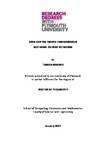User-Centric Traffic Engineering in Software Defined Networks
| dc.contributor.supervisor | Ghita, Bogdan | |
| dc.contributor.author | Bakhshi, Taimur | |
| dc.contributor.other | School of Engineering, Computing and Mathematics | en_US |
| dc.date.accessioned | 2017-01-05T14:52:34Z | |
| dc.date.issued | 2017 | |
| dc.date.issued | 2017 | |
| dc.identifier | 10113094 | en_US |
| dc.identifier.uri | http://hdl.handle.net/10026.1/8202 | |
| dc.description.abstract |
Software defined networking (SDN) is a relatively new paradigm that decouples individual network elements from the control logic, offering real-time network programmability, translating high level policy abstractions into low level device configurations. The framework comprises of the data (forwarding) plane incorporating network devices, while the control logic and network services reside in the control and application planes respectively. Operators can optimize the network fabric to yield performance gains for individual applications and services utilizing flow metering and application-awareness, the default traffic management method in SDN. Existing approaches to traffic optimization, however, do not explicitly consider user application trends. Recent SDN traffic engineering designs either offer improvements for typical time-critical applications or focus on devising monitoring solutions aimed at measuring performance metrics of the respective services. The performance caveats of isolated service differentiation on the end users may be substantial considering the growth in Internet and network applications on offer and the resulting diversity in user activities. Application-level flow metering schemes therefore, fall short of fully exploiting the real-time network provisioning capability offered by SDN instead relying on rather static traffic control primitives frequent in legacy networking. For individual users, SDN may lead to substantial improvements if the framework allows operators to allocate resources while accounting for a user-centric mix of applications. This thesis explores the user traffic application trends in different network environments and proposes a novel user traffic profiling framework to aid the SDN control plane (controller) in accurately configuring network elements for a broad spectrum of users without impeding specific application requirements. This thesis starts with a critical review of existing traffic engineering solutions in SDN and highlights recent and ongoing work in network optimization studies. Predominant existing segregated application policy based controls in SDN do not consider the cost of isolated application gains on parallel SDN services and resulting consequence for users having varying application usage. Therefore, attention is given to investigating techniques which may capture the user behaviour for possible integration in SDN traffic controls. To this end, profiling of user application traffic trends is identified as a technique which may offer insight into the inherent diversity in user activities and offer possible incorporation in SDN based traffic engineering. A series of subsequent user traffic profiling studies are carried out in this regard employing network flow statistics collected from residential and enterprise network environments. Utilizing machine learning techniques including the prominent unsupervised k-means cluster analysis, user generated traffic flows are cluster analysed and the derived profiles in each networking environment are benchmarked for stability before integration in SDN control solutions. In parallel, a novel flow-based traffic classifier is designed to yield high accuracy in identifying user application flows and the traffic profiling mechanism is automated. The core functions of the novel user-centric traffic engineering solution are validated by the implementation of traffic profiling based SDN network control applications in residential, data center and campus based SDN environments. A series of simulations highlighting varying traffic conditions and profile based policy controls are designed and evaluated in each network setting using the traffic profiles derived from realistic environments to demonstrate the effectiveness of the traffic management solution. The overall network performance metrics per profile show substantive gains, proportional to operator defined user profile prioritization policies despite high traffic load conditions. The proposed user-centric SDN traffic engineering framework therefore, dynamically provisions data plane resources among different user traffic classes (profiles), capturing user behaviour to define and implement network policy controls, going beyond isolated application management. | en_US |
| dc.language.iso | en | |
| dc.publisher | University of Plymouth | |
| dc.rights | CC0 1.0 Universal | * |
| dc.rights.uri | http://creativecommons.org/publicdomain/zero/1.0/ | * |
| dc.subject | Network measurement | |
| dc.subject | Machine learning | |
| dc.subject | User profiling | |
| dc.subject | Software defined networking | en_US |
| dc.subject.classification | PhD | en_US |
| dc.title | User-Centric Traffic Engineering in Software Defined Networks | en_US |
| dc.type | Thesis | |
| plymouth.version | publishable | en_US |
| dc.identifier.doi | http://dx.doi.org/10.24382/570 | |
| dc.rights.embargodate | 2018-01-05T14:52:34Z | |
| dc.rights.embargoperiod | 12 months | en_US |
| dc.type.qualification | Doctorate | en_US |
| rioxxterms.funder | Not available | en_US |
| rioxxterms.identifier.project | Not available | en_US |
| rioxxterms.version | NA | |
| plymouth.orcid-id | 0000-0003-4750-7864 | en_US |
Files in this item
This item appears in the following Collection(s)
-
01 Research Theses Main Collection
Research Theses Main



